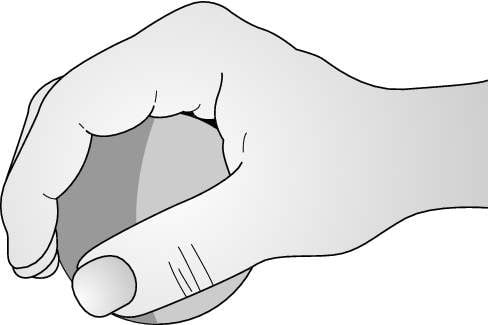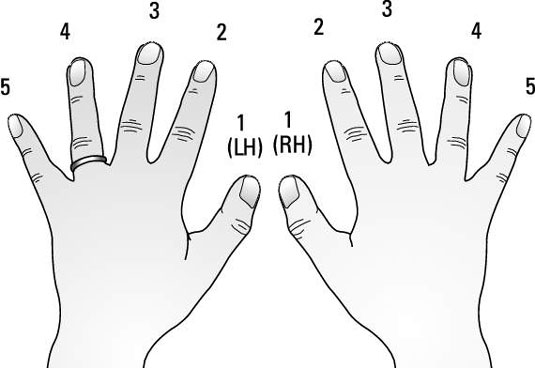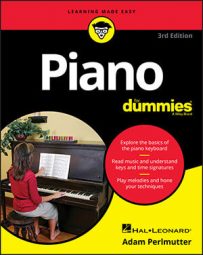-
Lack of dexterity: If your hands are in tight, awkward positions, you can’t access the keys quickly and efficiently. Your performance will sound clumsy and be full of wrong notes.
-
Potential for cramping: If your hands cramp often, you won’t practice often. If you don’t practice often, you won’t be a very good player.
Arch those hands and fingers
When you place your hands on the keys, you must keep your hands arched and your fingers slightly curled at all times. It feels weird at first, but you can’t improve your playing technique until you get used to holding your hands this way. Arching your hands and fingers pays off with the following benefits:-
Your hands don’t get tired as quickly.
-
Your hands are less likely to cramp.
-
You can quickly and easily access any key, black or white.
Watch this piano video clip in Chapter 5 to make sure you have a handle on arching both your hands and fingers.

Fingering
Fingering refers to using the best finger to play each note of a song, and correct fingering is always a very important part of piano playing. Some pieces, even the easy ones, have fingerings marked in the sheet music to help you plan which fingers to use to execute a particular musical passage most efficiently and comfortably.Number your fingers 1 through 5, beginning with the thumb as number 1 and moving toward the little finger, or pinkie.

While you get used to thinking of your fingers in terms of numbers, you may find it helpful to write these numbers on your hands before you sit down to practice. Use washable marker or pen. Otherwise, you’ll have to explain those numbered fingers to your date on Friday night, your boss on Monday morning, or your homeroom teacher.
Give your hands and fingers a rest
Poor posture can lead to the beginning of serious and painful problems in your piano career. The sports claim “no pain, no gain” has no validity when applied to piano playing. Muscle tension and poor posture can cause pain. If you hurt, you won’t play. If you don’t play, you won’t be very good.Feeling cramped
Even if your posture is absolutely perfect, your hands will inevitably begin to cramp at some point. Cramps are your body’s way of saying, “Hey, let’s go do something else for a while.” By all means, listen to your body.Generally, you’ll experience hand cramps long before you experience any other kind of body cramp during practice. Your back and neck may become sore from poor posture, but your hands will begin to cramp simply from too much use.
If your hands hurt, take a long break and do something that creates a completely opposite hand action. For example, throwing a ball to your dog is an opposite hand action; typing is not. If your whole body hurts, get a massage (including a hand massage) or take a luxurious cruise in the South Pacific. You deserve it.
Avoiding carpal tunnel syndrome
Much has been said about a career-oriented injury called carpal tunnel syndrome (CTS). Without getting into its technical definition, which would require a degree in medicine, suffice it to say that CTS develops from overstraining the muscles and ligaments in your wrist through a constant, repetitive action. And piano playing is a constant, repetitive action. As you can probably imagine, many a keyboardist and full-time blogger experience CTS during their careers. Unfortunately, many wait until it’s too late for a simple remedy. They ignore what starts out as a dull pain in the forearms, wrists, and fingers until it becomes a severe pain whenever the hands are in motion.Severe CTS requires surgery to remedy, but the results aren’t always 100 percent successful. As a piano player, you need 100 percent of your hand motion, so don’t let any pain go unaddressed.
If you’re bothered by pain in your wrists, no matter how minor, consult your physician for ways to reduce or prevent it. Of course, if you’ve already been diagnosed with CTS, talk with your physician about your piano-playing goals and ask what steps you can take to prevent any further damage or pain.

